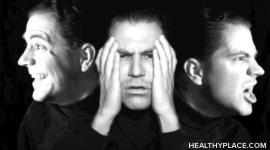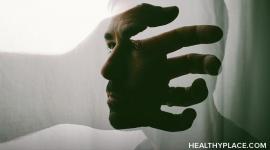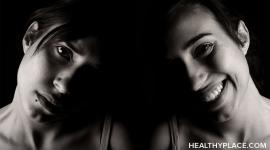Diagnosing Bipolar Disorder

Detailed explanation of diagnosing bipolar disorder. Take our mood disorders test (bipolar test).
Bipolar disorder is characterized by mood that alternates between two emotional extremes, or poles: the sadness of depression and the euphoria of mania (see symptoms of mania below).
Between these emotional swings, there are periods when a person's mood is quite normal. When a person is in the depressed phase of bipolar illness, he or she will have the same symptoms as those found in major depressive disorder. The depressive episodes can often be severe. While in a manic phase, a person experiences mood that is extremely elevated, expansive, or irritable. Mania can seriously impair one's normal judgment. When manic, a person is prone to reckless and inappropriate behavior such as engaging in wild spending sprees or having promiscuous sex. He or she may not be able to realize the harm of his/her behavior and may even lose touch with reality.
Two Types of Bipolar Disorder
Bipolar I Disorder is diagnosed when a person has had at least one manic or mixed episode, often along with a major depressive episode. It affects equal numbers of men and women in approximately 0.4% to 1.6% of the population.
Bipolar II Disorder is diagnosed when a person has had a major depressive episode along with at least one hypomanic episode. It affects more women than men in about 0.5% of the population.
Depressed Phase of Bipolar
People with bipolar disorder experience a wide range of feelings depending on the phase of the illness that is present. During a phase of depression, a person will have many of the symptoms of a major depressive episode. He or she may have despondent mood, a loss of energy, feelings of worthlessness or guilt, or problems with concentration. Thoughts of suicide are not uncommon. In fact, 10% to 15% of those with bipolar disorder may die by suicide.
If the depression is severe, a person may need to be hospitalized for his or her own safety. For those who go through a phase of hypomania, the experience usually feels quite good. A person's mood and spirit lighten, he or she will be more outgoing and notice more energy and enhanced self-esteem. Lots of ideas come with ease and a person may feel compelled towards greater activity and productivity. A person in a hypomanic phase may also feel more powerful and omnipotent.
Bipolar Mania
The manic phase is the most extreme part of bipolar disorder. A person becomes euphoric, ideas come much too fast, and concentration is nearly impossible. Anger, irritability, fear, and a sense of being out of control are overwhelming. A person's judgment is impaired, and he or she may behave recklessly without a sense of consequence. Some people lose touch with reality and experience delusions and hallucinations. When this happens, people often need to be hospitalized for their own safety. If a person with bipolar disorder experiences a severe manic episode, he or she may be abusive to children, spouses, or engage in other violent behaviors. There may also be problems with attendance and performance at school or work, as well as significant difficulties in personal relationships.
Cycles of Bipolar Disorder
The cycles of bipolar disorder may be different for each person. Oftentimes a person may first experience depression. Then depression may be replaced with manic symptoms and the cycle between depression and mania may continue for days, weeks, or months. Between phases of depression and mania some people return to their normal mood. Some others have several periods of either depression or mania. Still others may experience several bouts of depression with infrequent phases of hypomania, or repeated manic episodes with occasional depressive periods. A portion of people, roughly 10% to 20% may only experience mania, while others can have both depression and mania at the same time.
For at least 90% of those who have bipolar disorder the condition is recurrent. They will experience future symptoms of the cycles of mania and depression. Approximately 60%-70% of manic episodes may happen just before or after a depressive episode, and this pattern may happen in a particular way for each person. Most people return to a regular level of functioning between episodes, while some (about 20%-30%) may continue to have some problems with mood stability and social and occupational functioning.
Bipolar I disorder affects equal numbers of males and females, however, there does appear to be a gender difference in the onset of the illness. Females are more likely to experience a first episode of depression, while males tend to have a first episode that is manic. Women who have bipolar I or II disorder and who have children may be at a higher risk of experiencing bipolar episodes within several months of giving birth.
A first episode of mania is most likely to occur when a person is in his/her teens or twenties. If a person develops bipolar disorder for the first time after 40 years of age, he or she should be evaluated for the possibility of a medical illness or substance use.
People who have immediate relatives with bipolar I disorder have a higher risk of developing a mood disorder themselves. For these people, the rate of developing bipolar II disorder or major depression is 4%-24% and bipolar I disorder is 1%-5%.
Of adolescents who have recurrent major depressive episodes, about 10%-15% of them will likely develop bipolar disorder.
Diagnosis of Bipolar I Disorder
A. A person experiences a current or recent episode that is manic, hypomanic, mixed, or depressed.
- To be a manic episode, for at least one week a person's mood must be out of the ordinary and continuously heightened, exaggerated, or irritable.
- At least three of the following seven symptoms have been significant and enduring. If the mood is only irritable, then four symptoms are required.
- Self-esteem is excessive or grandiose.
- The need for sleep is greatly reduced.
- Talks much more than usual.
- Thoughts and ideas are continuous and without a pattern or focus.
- Easily distracted by unimportant things.
- An increase in purposeful activity or productivity, or behaving and feeling agitated.
- Reckless participation in enjoyable activities that create a high risk for negative consequences (e.g., extensive spending sprees, sexual promiscuity).
- The persons' symptoms do not indicate a mixed episode.
- The person's symptoms are a cause of great distress or difficulty in functioning at home, work, or other important areas. Or, the symptoms require the person to be hospitalized to protect the person from harming himself/herself or others. Or, the symptoms include psychotic features (hallucinations, delusions).
- The person's symptoms are not caused by substance use (e.g., alcohol, drugs, medication), or a medical disorder.
B. Unless this is a first single manic episode there has been at least one manic, mixed, hypomanic, or depressive episode.
- For a major depressive episode a person must have experienced at least five of the nine symptoms below for the same two weeks or more, for most of the time almost every day, and this is a change from his/her prior level of functioning. One of the symptoms must be either (a) depressed mood, or (b) loss of interest.
- Depressed mood. For children and adolescents, this may be irritable mood.
- A significantly reduced level of interest or pleasure in most or all activities.
- A considerable loss or gain of weight (e.g., 5% or more change of weight in a month when not dieting). This may also be an increase or decrease in appetite. For children, they may not gain an expected amount of weight.
- Difficulty falling or staying asleep (insomnia), or sleeping more than usual (hypersomnia).
- Behavior that is agitated or slowed down. Others should be able to observe this.
- Feeling fatigued, or diminished energy.
- Thoughts of worthlessness or extreme guilt (not about being ill).
- Ability to think, concentrate, or make decisions is reduced.
- Frequent thoughts of death or suicide (with or without a specific plan), or attempt of suicide.
- The persons' symptoms do not indicate a mixed episode.
- The person's symptoms are a cause of great distress or difficulty in functioning at home, work, or other important areas.
- The person's symptoms are not caused by substance use (e.g., alcohol, drugs, medication), or a medical disorder.
- The person's symptoms are not due to normal grief or bereavement over the death of a loved one, they continue for more than two months, or they include great difficulty in functioning, frequent thoughts of worthlessness, thoughts of suicide, symptoms that are psychotic, or behavior that is slowed down (psychomotor retardation).
C. Another disorder does not better explain the episode.
Diagnosis of Bipolar II Disorder
A. The person currently has, or in the past has had at least one major depressive episode:
- For a major depressive episode a person must have experienced at least five of the nine symptoms below for the same two weeks or more, for most of the time almost every day, and this is a change from his/her prior level of functioning. One of the symptoms must be either (a) depressed mood, or (b) loss of interest.
- Depressed mood. For children and adolescents, this may be irritable mood.
- A significantly reduced level of interest or pleasure in most or all activities.
- A considerable loss or gain of weight (e.g., 5% or more change of weight in a month when not dieting). This may also be an increase or decrease in appetite. For children, they may not gain an expected amount of weight.
- Difficulty falling or staying asleep (insomnia), or sleeping more than usual (hypersomnia).
- Behavior that is agitated or slowed down. Others should be able to observe this.
- Feeling fatigued, or diminished energy.
- Thoughts of worthlessness or extreme guilt (not about being ill).
- Ability to think, concentrate, or make decisions is reduced.
- Frequent thoughts of death or suicide (with or without a specific plan), or attempt of suicide.
- The persons' symptoms do not indicate a mixed episode.
- The person's symptoms are a cause of great distress or difficulty in functioning at home, work, or other important areas.
- The person's symptoms are not caused by substance use (e.g., alcohol, drugs, medication), or a medical disorder.
- The person's symptoms are not due to normal grief or bereavement over the death of a loved one, they continue for more than two months, or they include great difficulty in functioning, frequent thoughts of worthlessness, thoughts of suicide, symptoms that are psychotic, or behavior that is slowed down (psychomotor retardation).
B. The person currently has, or in the past has had at least one hypomanic episode:
- For a hypomanic episode a person's mood must be out of the ordinary and continuously heightened, exaggerated, or irritable for at least four days.
- At least three of the following seven symptoms have been significant and enduring. If the mood is only irritable, then four symptoms are required.
- Self-esteem is excessive or grandiose.
- The need for sleep is greatly reduced.
- Talks much more than usual.
- Thoughts and ideas are continuous and without a pattern or focus.
- Easily distracted by unimportant things.
- An increase in purposeful activity or productivity, or behaving and feeling agitated.
- Reckless participation in enjoyable activities that create a high risk for negative consequences (e.g., extensive spending sprees, sexual promiscuity).
- The episode is a substantial change for the person and uncharacteristic of his or her usual functioning.
- The changes of functioning and mood can be observed by others.
- The person's symptoms are NOT severe enough to cause difficulty in functioning at home, work, or other important areas. Also, the symptoms neither require the person to be hospitalized, nor are there any psychotic features.
- The person's symptoms are not caused by substance use (e.g., alcohol, drugs, medication), or a medical disorder. C. The person has never experienced a manic or mixed episode. D. Another disorder does not better explain the episode. E. The symptoms are a cause of great distress or difficulty in functioning at home, work, or other important areas.
APA Reference
Tracy, N.
(2021, January 3). Diagnosing Bipolar Disorder, HealthyPlace. Retrieved
on 2026, January 22 from https://www.healthyplace.com/depression/bipolar/diagnosing-bipolar-disorder


